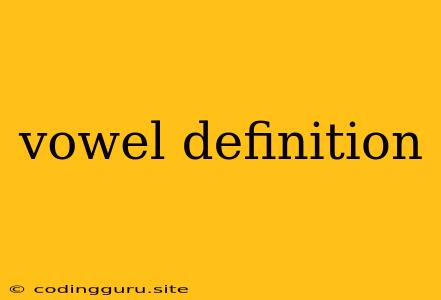What are Vowels?
Vowels are the building blocks of language, forming the foundation of spoken and written words. They are the sounds that are produced with an open vocal tract, allowing air to flow freely without any obstruction. This open airflow creates a clear and resonant sound, unlike consonants which involve constrictions or closures in the mouth.
How are Vowels Produced?
Vowels are characterized by the position of the tongue and the shape of the mouth. The height and forwardness of the tongue, as well as the degree of lip rounding, all contribute to the unique sound of each vowel.
Tongue Position:
- High vowels: The tongue is raised towards the roof of the mouth, like in the sounds /i/ (as in "eet") and /u/ (as in "food").
- Low vowels: The tongue is lowered, as in the sound /a/ (as in "fat").
- Front vowels: The tongue is positioned further forward in the mouth, as in the sounds /i/ and /e/ (as in "bed").
- Back vowels: The tongue is positioned further back in the mouth, as in the sounds /u/ and /o/ (as in "boat").
Lip Rounding:
- Rounded vowels: The lips are rounded, as in the sounds /u/ and /o/.
- Unrounded vowels: The lips are relaxed, as in the sounds /i/, /e/, and /a/.
The Importance of Vowels in Language:
- Speech Production: Vowels are essential for the production of spoken language. They provide the core sound of syllables and words.
- Written Language: Vowels are represented in written language, helping to distinguish words and their meanings.
- Understanding Meaning: Vowels play a crucial role in understanding the meaning of words. Different vowel sounds can change the meaning of a word entirely. For example, "cat" and "cot" have different meanings despite only differing in their vowel sound.
- Rhythm and Melody: Vowels contribute to the rhythm and melody of language. Their duration and stress patterns create the flow and musicality of spoken words.
Example of Vowels in English:
The English language has a variety of vowel sounds, represented by both single and multi-letter combinations. Here are some examples:
Single Letter Vowels:
- a as in "at"
- e as in "met"
- i as in "bit"
- o as in "hot"
- u as in "but"
Multi-Letter Vowels:
- ai as in "train"
- au as in "caught"
- ee as in "tree"
- oa as in "goat"
- oo as in "moon"
Conclusion:
Vowels are the fundamental building blocks of language, shaping both spoken and written words. Their production, characteristics, and importance are key elements in understanding how language works and how we communicate with each other.
